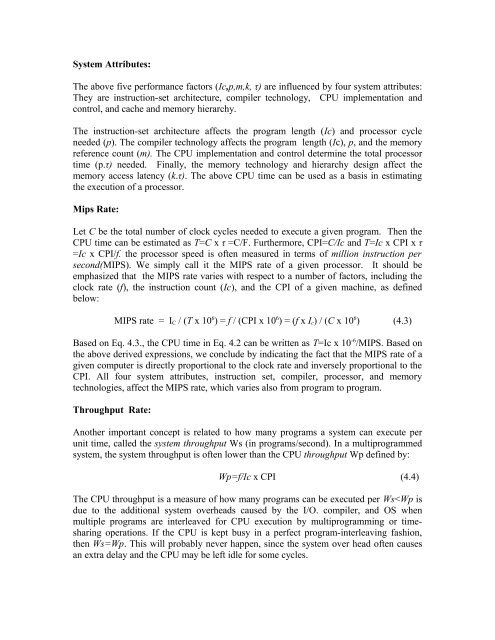UNIT-4: PARALLEL COMPUTER MODELS STRUCTURE - Csbdu.in
UNIT-4: PARALLEL COMPUTER MODELS STRUCTURE - Csbdu.in
UNIT-4: PARALLEL COMPUTER MODELS STRUCTURE - Csbdu.in
Create successful ePaper yourself
Turn your PDF publications into a flip-book with our unique Google optimized e-Paper software.
System Attributes:<br />
The above five performance factors (Ic,p,m,k, τ) are <strong>in</strong>fluenced by four system attributes:<br />
They are <strong>in</strong>struction-set architecture, compiler technology, CPU implementation and<br />
control, and cache and memory hierarchy.<br />
The <strong>in</strong>struction-set architecture affects the program length (Ic) and processor cycle<br />
needed (p). The compiler technology affects the program length (Ic), p, and the memory<br />
reference count (m). The CPU implementation and control determ<strong>in</strong>e the total processor<br />
time (p.τ) needed. F<strong>in</strong>ally, the memory technology and hierarchy design affect the<br />
memory access latency (k.τ). The above CPU time can be used as a basis <strong>in</strong> estimat<strong>in</strong>g<br />
the execution of a processor.<br />
Mips Rate:<br />
Let C be the total number of clock cycles needed to execute a given program. Then the<br />
CPU time can be estimated as T=C x τ =C/F. Furthermore, CPI=C/Ic and T=Ic x CPI x τ<br />
=Ic x CPI/f. the processor speed is often measured <strong>in</strong> terms of million <strong>in</strong>struction per<br />
second(MIPS). We simply call it the MIPS rate of a given processor. It should be<br />
emphasized that the MIPS rate varies with respect to a number of factors, <strong>in</strong>clud<strong>in</strong>g the<br />
clock rate (f), the <strong>in</strong>struction count (Ic), and the CPI of a given mach<strong>in</strong>e, as def<strong>in</strong>ed<br />
below:<br />
MIPS rate = IC / (T x 10 6 ) = f / (CPI x 10 6 ) = (f x Ic) / (C x 10 6 ) (4.3)<br />
Based on Eq. 4.3., the CPU time <strong>in</strong> Eq. 4.2 can be written as T=Ic x 10 -6 /MIPS. Based on<br />
the above derived expressions, we conclude by <strong>in</strong>dicat<strong>in</strong>g the fact that the MIPS rate of a<br />
given computer is directly proportional to the clock rate and <strong>in</strong>versely proportional to the<br />
CPI. All four system attributes, <strong>in</strong>struction set, compiler, processor, and memory<br />
technologies, affect the MIPS rate, which varies also from program to program.<br />
Throughput Rate:<br />
Another important concept is related to how many programs a system can execute per<br />
unit time, called the system throughput Ws (<strong>in</strong> programs/second). In a multiprogrammed<br />
system, the system throughput is often lower than the CPU throughput Wp def<strong>in</strong>ed by:<br />
Wp=f/Ic x CPI (4.4)<br />
The CPU throughput is a measure of how many programs can be executed per Ws















